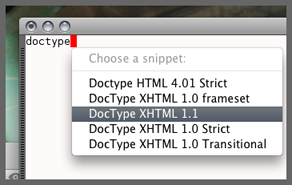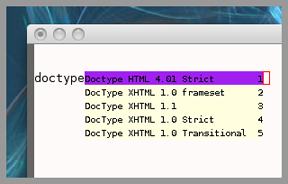This is just the initial conversion with pandoc, they still need to be fixed up. Also define new org files as a project in yas-doc-helper.el.
12 KiB
Expanding snippets
Triggering expansion
You can use YASnippet to expand snippets in different ways:
- By typing an abbrev, the snippet trigger key, and then pressing the
key defined in
yas-trigger-key(which defaults to "TAB"). This works in buffers where the minor modeyas-minor-modeis active; - By invoking the command
yas-insert-snippet(either by typingM-x yas-insert-snippetor its keybinding). This does not requireyas-minor-modeto be active. - By using the keybinding associated with an active snippet. This also
requires
yas-minor-modeto be active; - By expanding directly from the "YASnippet" menu in the menu-bar
- By using hippie-expand
- Expanding from emacs-lisp code
Trigger key
When yas-minor-mode is enabled, the keybinding taken from
yas-trigger-key will take effect.
yas-trigger-key invokes yas-expand, which tries to expand a snippet
abbrev (also known as snippet key) before point.
The default key is "TAB", however, you can freely set it to some other
key.

To enable the YASnippet minor mode in all buffers globally use the
command yas-global-mode.
When you use yas-global-mode you can also selectively disable
YASnippet in some buffers by setting the buffer-local variable
yas-dont-active in the buffer's mode hook.
Trouble when using or understanding the yas-trigger-key is easily the
most controversial issue in YASsnippet. See the FAQ.
Fallback bahaviour
yas-fallback-behaviour is a customization variable bound to
'call-other-command by default. If yas-expand failed to find any
suitable snippet to expand, it will disable the minor mode temporarily
and find if there's any other command bound the yas-trigger-key.
If found, the command will be called. Usually this works very well –when there's a snippet, expand it, otherwise, call whatever command originally bind to the trigger key.
However, you can change this behavior by customizing the
yas-fallback-behavior variable. If you set this variable to
'return-nil, it will return nil instead of trying to call the
original command when no snippet is found.
Insert at point
The command M-x yas-insert-snippet lets you insert snippets at point
for you current major mode. It prompts you for the snippet key first,
and then for a snippet template if more than one template exists for the
same key.
The list presented contains the snippets that can be inserted at point,
according to the condition system. If you want to see all applicable
snippets for the major mode, prefix this command with C-u.
The prompting methods used are again controlled by
yas-prompt-functions.
Snippet keybinding
See the section of the # binding: directive in
Writing Snippets.
Expanding from the menu
See the YASnippet Menu.
Expanding with hippie-expand
To integrate with hippie-expand, just put yas-hippie-try-expand in
hippie-expand-try-functions-list. This probably makes more sense when
placed at the top of the list, but it can be put anywhere you prefer.
Expanding from emacs-lisp code
Sometimes you might want to expand a snippet directly from you own elisp
code. You should call yas-expand-snippet instead of yas-expand in
this case.
As with expanding from the menubar, the condition system and multiple candidates doesn't affect expansion. In fact, expanding from the YASnippet menu has the same effect of evaluating the follow code:
See the internal documentation on yas-expand-snippet for more
information.
Controlling expansion
Eligible snippets
YASnippet does quite a bit of filtering to find out which snippets are eligible for expanding at the current cursor position.
In particular, the following things matter:
- Currently loaded snippets tables
These are loaded from a directory hierarchy in your file system. See
Organizing Snippets. They are named
after major modes like
html-mode,ruby-mode, etc… - Major mode of the current buffer
If the currrent major mode matches one of the loaded snippet tables,
then all that table's snippets are considered for expansion. Use
M-x describe-variable RET major-mode RETto find out which major mode you are in currently. - Parent tables Snippet tables defined as the parent of some other eligible table are also considered. This works recursively, i.e. parents of parents of eligible tables are also considered.
- Buffer-local
yas-mode-symbolvariable This can be used to consider snippet tables whose name does not correspond to a major mode. If you set this variable to a name , likerinari-minor-mode, you can have some snippets expand only in that minor mode. Naturally, you want to set this conditionally, i.e. only when entering that minor mode, so using a hook is a good idea. - Buffer-local
yas-buffer-local-conditionvariable This variable provides finer grained control over what snippets can be expanded in the current buffer. The default value won't let you expand snippets inside comments or string literals for example. See The condition system for more info.
The condition system
Consider this scenario: you are an old Emacs hacker. You like the
abbrev-way and set yas-trigger-key to "SPC". However, you don't want
if to be expanded as a snippet when you are typing in a comment block
or a string (e.g. in python-mode).
If you use the # condition : directive (see
Writing Snippets) you could just specify
the condition for if to be (not (python-in-string/comment)). But how
about while, for, etc. ? Writing the same condition for all the
snippets is just boring. So has a buffer local variable
yas-buffer-local-condition. You can set this variable to
(not (python-in-string/comment)) in python-mode-hook.
Then, what if you really want some particular snippet to expand even inside a comment? This is also possible! But let's stop telling the story and look at the rules:
- If
yas-buffer-local-conditionevaluate to nil, no snippets will be considered for expansion. -
If it evaluates to the a cons cell where the
caris the symbolrequire-snippet-conditionand thecdris a symbol (let's call itrequirement), then:- Snippets having no
# condition:directive won't be considered; - Snippets with conditions that evaluate to nil (or produce an error) won't be considered;
-
If the snippet has a condition that evaluates to non-nil (let's call it
result):- If
requirementist, the snippet is ready to be expanded; - If
requirementiseqtoresult, the snippet is ready to be expanded; - Otherwise the snippet won't be considered.
- If
- Snippets having no
- If it evaluates to the symbol
always, all snippets are considered for expansion, regardless of any conditions. -
If it evaluate to
tor some other non-nil value:- If the snippet has no condition, or has a condition that evaluate to non-nil, it is ready to be expanded.
- Otherwise, it won't be considered.
In the mentioned scenario, set yas-buffer-local-condition like this
… and specify the condition for a snippet that you're going to expand
in comment to be evaluated to the symbol force-in-comment. Then it can
be expanded as you expected, while other snippets like if still can't
expanded in comment.
Multiples snippet with the same key
The rules outlined above can return more than one snippet to be expanded at point.
When there are multiple candidates, YASnippet will let you select one.
The UI for selecting multiple candidate can be customized through
yas-prompt-functions , which defines your preferred methods of being
prompted for snippets.
You can customize it with
M-x customize-variable RET yas-prompt-functions RET. Alternatively you
can put in your emacs-file:
Currently there are some alternatives solution with YASnippet.

Use the X window system
The function yas-x-prompt can be used to show a popup menu for you to
select. This menu will be part of you native window system widget, which
means:
- It usually looks beautiful. E.g. when you compile Emacs with gtk support, this menu will be rendered with your gtk theme.
- Your window system may or may not allow to you use
C-n,C-pto navigate this menu. - This function can't be used when in a terminal.

Minibuffer prompting
You can use functions yas-completing-prompt for the classic emacs
completion method or yas-ido-prompt for a much nicer looking method.
The best way is to try it. This works in a terminal.

Use dropdown-menu.el
The function yas-dropdown-prompt can also be placed in the
yas-prompt-functions list.
This works in both window system and terminal and is customizable, you
can use C-n, C-p to navigate, q to quit and even press 6 as a
shortcut to select the 6th candidate.
Roll your own
See below for the documentation on variable yas-prompt-functions
Customizable Variables
yas-prompt-functions
You can write a function and add it to the yas-prompt-functions list.
These functions are called with the following arguments:
- PROMPT: A string to prompt the user;
- CHOICES: A list of strings or objects;
- optional DISPLAY-FN : A function. When applied to each of the objects in CHOICES it will return a string;
The return value of any function you put here should be one of the objects in CHOICES, properly formatted with DISPLAY-FN (if that is passed).
- To signal that your particular style of prompting is unavailable at the moment, you can also have the function return nil.
- To signal that the user quit the prompting process, you can signal
quitwith(signal 'quit "user quit!")
yas-fallback-behavior
How to act when yas-expand does not expand a snippet.
call-other-commandmeans try to temporarily disable YASnippet and :: call the next command bound toyas-trigger-key.
return-nil means return nil. (i.e. do nothing)
An entry (apply COMMAND . ARGS) means interactively call COMMAND, if ARGS is non-nil, call COMMAND non-interactively with ARGS as arguments.
yas-choose-keys-first
If non-nil, prompt for snippet key first, then for template.
Otherwise prompts for all possible snippet names.
This affects yas-insert-snippet and yas-visit-snippet-file.
yas-choose-tables-first
If non-nil, and multiple eligible snippet tables, prompts user for tables first.
Otherwise, user chooses between the merging together of all eligible tables.
This affects yas-insert-snippet, yas-visit-snippet-file
yas-key-syntaxes
The default searching strategy is quite powerful. For example, in
c-mode, bar, foo_bar, "#foo_bar" can all be recognized as a
snippet key. Furthermore, the searching is in that order. In other
words, if bar is found to be a key to some valid snippet, then that
snippet is expanded and replaces the bar. Snippets pointed to by
foo_bar and "#foobar won't be considered.
However, this strategy can also be customized easily from the
yas-key-syntaxes variable. It is a list of syntax rules, the default
value is ("w" "w_" "w_." "^ "). Which means search the following thing
until found one:
- a word.
- a symbol. In lisp,
-and?can all be part of a symbol. - a sequence of characters of either word, symbol or punctuation.
- a sequence of characters of non-whitespace characters.
But you'd better keep the default value unless you want to understand how Emacs's syntax rules work…